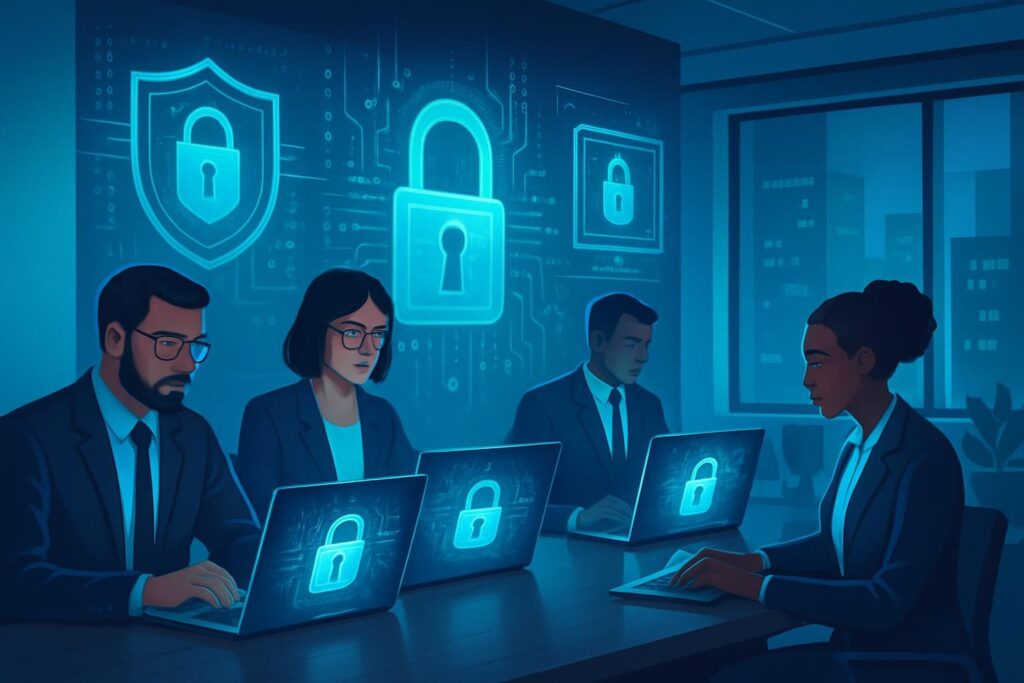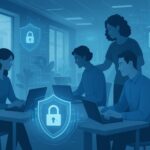
In today’s hyper-connected world, workplace cybersecurity is no longer just an IT concern—it’s a survival skill for professionals, businesses, and organizations of all sizes. With remote work, cloud collaboration, and the rise of AI-driven tools, safeguarding workplace data has become more critical than ever. Whether you’re an employee managing sensitive information or a leader responsible for entire networks, understanding workplace cybersecurity can mean the difference between resilience and costly vulnerabilities.
Why Workplace Cybersecurity Matters More Than Ever
The modern workplace thrives on digital tools. But every convenience—from email communication to file sharing—creates new entry points for hackers. A single phishing email or weak password can trigger a devastating breach, costing organizations millions in damages, not to mention trust. Workplace cybersecurity protects not just data, but reputations, careers, and long-term business stability.
- Safeguards customer trust and brand reputation
- Reduces downtime and operational losses
- Ensures compliance with evolving regulations
Common Workplace Cybersecurity Threats You Need to Know
Understanding threats is the first step to defending against them. Here are the most common workplace cybersecurity risks employees and companies face daily:
- Phishing Attacks – Fake emails or messages tricking employees into revealing sensitive data.
- Weak Passwords – Easy-to-guess logins that open the door to unauthorized access.
- Malware and Ransomware – Malicious software that steals or locks company data until a ransom is paid.
- Insider Threats – Employees or contractors misusing access intentionally or accidentally.
- Unsecured Wi-Fi Networks – A frequent risk in remote or hybrid work setups.
The Role of Employees in Workplace Cybersecurity
Cybersecurity is not solely the IT department’s job—it’s a shared responsibility. Every employee plays a vital role in safeguarding workplace data. From following password hygiene practices to reporting suspicious activity, employee awareness and action are frontline defenses against cyberattacks.
Workplace Cybersecurity Best Practices for Employees
- Use Strong Passwords and MFA: Combine complex characters and enable multi-factor authentication.
- Verify Before You Click: Always confirm suspicious links or attachments before opening.
- Keep Devices Updated: Install patches and security updates regularly.
- Separate Work and Personal Devices: Avoid mixing business tasks with personal browsing.
- Report Incidents Quickly: The faster IT knows about a threat, the better the chances of neutralizing it.
Workplace Cybersecurity for Remote and Hybrid Teams
The rise of remote work makes workplace cybersecurity more challenging. Employees logging in from cafes, airports, or home networks expose companies to new risks. Organizations should:
- Provide VPNs for secure connections
- Enforce strong device management policies
- Train staff on secure file-sharing practices
- Encourage the use of company-approved collaboration tools
Remote work doesn’t have to compromise workplace cybersecurity if the right safeguards are in place.
Workplace Cybersecurity Tools Every Professional Should Use
- Password Managers: Reduce weak or reused password risks.
- VPNs: Encrypt online activity over public and home networks.
- Endpoint Security: Protect devices from malware and exploits.
- Email Security Filters: Catch phishing before it hits inboxes.
- Cloud Security Monitoring: Safeguard collaborative platforms and file storage.
The Cost of Ignoring Workplace Cybersecurity
Data breaches cost organizations more than money. They damage customer trust, tarnish brand reputations, and can lead to regulatory fines. The cost of prevention is always lower than the cost of recovery.
How Leaders Can Build a Cyber-Smart Workplace
- Establish clear cybersecurity policies and acceptable use standards
- Offer regular training and workshops with realistic simulations
- Create an open culture where reporting threats is encouraged
- Allocate budgets for updated tools and timely patching
Future Trends in Workplace Cybersecurity
- AI in Cyber Defense: Machine learning detecting attacks in real time
- Zero-Trust Frameworks: “Never trust, always verify” replacing perimeter models
- Quantum-Resistant Encryption: Preparing for the next generation of computing threats
- Increased Regulations: Governments tightening data protection requirements globally
Frequently Asked Questions
What is workplace cybersecurity in simple terms?
Workplace cybersecurity is the practice of protecting company data, systems, and devices from cyber threats like hacking, phishing, or malware.
How often should companies train employees on workplace cybersecurity?
At least twice a year, with refreshers whenever new threats emerge or tooling changes significantly.
Is workplace cybersecurity only an IT issue?
No, it’s a shared responsibility. Employees are often the first line of defense through everyday choices.
What’s the most common workplace cybersecurity mistake employees make?
Using weak or reused passwords remains the top mistake, closely followed by clicking suspicious links.
Can small businesses afford workplace cybersecurity?
Yes, many affordable tools and best practices exist. Strong passwords, MFA, and a good VPN provide outsized protection.



